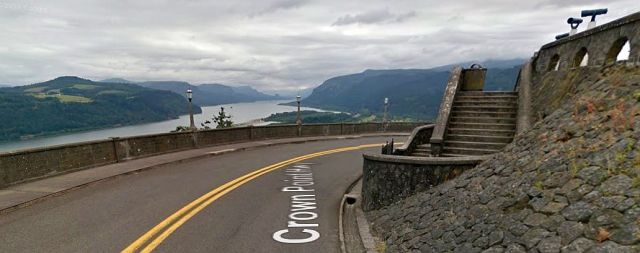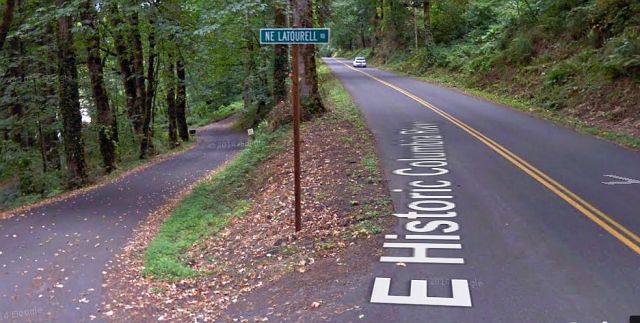Let’s continue our journey on the Historic Columbia Gorge Highway. This leg will take us past Guy Talbot State Park, Latourell Falls, Bridal Veil Falls State Park, Angel’s Rest, and Multnomah Falls.
This section of the historic highway passes by the largest number of waterfalls, many of which are easily accessed or observed from the road.
Vista House to Mult Falls
11. Heading East from Vista House (milepost 24)

Highway engineer Samuel Lancaster had to figure out how to get motorists from the top of Crown Point to the bottom of the hill, a drop of some 600 feet. Being sensitive to the landscape, Lancaster designed the “figure-eight loops” that gracefully wind down toward the river.
12. Guy Talbot State Park Rd (milepost 26)

Guy Talbot State Park was left by Guy Talbot and his family who used this property as a summer estate until 1929 when they donated it to the state. Today, it’s a beautiful picnic park, often uncrowded even on the best days because of its seclusion. The tiny town of Latourell borders the north side of the park.
13. Talbot/Corbett Park (panorama) (milepost 26)
14. Latourell Falls Trail Head (milepost 26)
Latourell Falls is within Guy W. Talbot State Park. Latourell is unique among the best-known Columbia Gorge waterfalls, in that it drops straight down from an overhanging basalt cliff, some 249 feet.
Latourell Falls Panorama
Follow the 2.4 mile trail loop uphill to the left of Latourell Falls (or sometimes referred to as the lower falls). At the first falls, you’ll see lichen-covered columnar basalt formations around the falls. Continue to the Upper Falls after crossing several bridges and following Henderson Creek to the two tiered drop of the upper falls.
15. NE Latourell Rd (milepost 27)

Latourell Falls and the town of Latourell were named for Joseph “Frenchy” Latourell who immigrated to Oregon in the 1850s. Latourell owned a mercantile and a fish wheel, and was a boatman on the Columbia River. At its height, Latourell was a working timber town and had five saloons and a well-known brass band.
17. Shepperd’s Dell Turnout (milepost 27)
18. Shepperd’s Dell Falls (milepost 27)
George Shepperd, a dairy farmer gave this tract of land to the City of Portland in 1915 as a memorial to his wife. The waterfall cascades down steep cliffs into Youngs Creek and out to the Columbia River far below. One of the most beautiful and historic highway bridges crosses the canyon here.
19. Bridal Veil Falls St Park (milepost 28)
Bridal Veil Falls State Park, near milepost 28 on the old highway, can also be accessed off I-84 at Exit 28. The park features two different trails: an upper walking/interpretive trail and a lower hiking trail to the falls (120′ tall). Both are not to be missed.
A geologic edifice known as the Pillars of Hercules, a 120-foot basalt tower, can be seen best from the upper trail at Bridal Veil.
20. Bridal Veil Viewpoint (milepost 29)
The lower trail at Bridal Veil takes you to the base of Bridal Veil Falls. There’s a great viewpoint where you look down on I-84 traffic, buzzing by and oblivious to you. The lower trail is about a mile round trip.
21.Angel’s Rest Parking (milepost 32)
Angel’s Rest is an exposed bluff overlooking the Gorge. A 2.4 mile one-way hike will take you up to the summit with a striking 270 degree view up and down the Gorge with a good view of Beacon Rock, Silver Star Mountain and other landmarks.
The forest surrounding the summit was burned in a fire back in 1991, with some charred evidence remaining. It is a unique landscape and one quite varied from other locales in the Gorge.
23. Wahkenna Falls (milepost 32)
The Multnomah-Wahkeena Loop Hike is a 4.9-mile trek that begins and ends in the Multnomah Falls parking lot.
Wahkenna Falls is a 242 foot (73 m) waterfall with a subtle cascading flow. A 0.2-mile (320 m) hike from the parking lot at the base leads to the stone bridge that crosses the main part of the falls. That trail continues on east to Multnomah Falls, the next falls to the east.
24. Multnomah Falls (milepost 32)
Multnomah Falls is the tallest waterfall in the state of Oregon. The falls drops in two major steps, split into an upper falls of 542 feet (165 m) and a lower falls of 69 feet (21 m), with a gradual 9 foot (3 m) drop in elevation between the two, with a total height generally given as 620 feet (189 m). Unlike many of the falls along the Gorge, Multnomah Falls does not dry up in the late summer. Rainwater, an underground spring and snow melt feed the falls through all four seasons.
A trail leads to Benson Footbridge, which crosses above the lower cascade. The trail continues to a platform at the top of the upper falls where visitors get a bird’s-eye view of the Columbia Gorge and also of “Little Multnomah”, a small cascade slightly upstream from the “upper” falls, which is not visible from ground level. The Historic Multnomah Falls Lodge features a restaurant, gift shop, hiking and visitor information.
The waterfall’s origins as a public park 100 years ago were anything but peaceful, explains Joe Rose in The Oregonian. “I don’t think most people realize just how close the falls came to being exploited as a source of power or something worse,” said Hal Meyerdierk, historian for Friends of Multnomah Falls.
The bridge is named for Simon Benson, who bought the falls in the early part of the 1900s to save it from being used for a sawmill. Benson, a retired lumberman and hotelier, in turn gave Multnomah Falls to the City of Portland, which later transferred ownership to the US Forest Service.
Simon Benson purchased many scenic spots along the highway, including Multnomah Falls, and donated them back to the state to preserve them for future generations.


